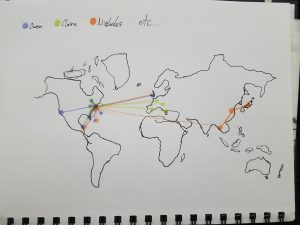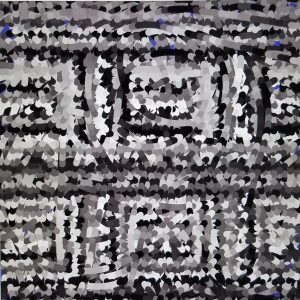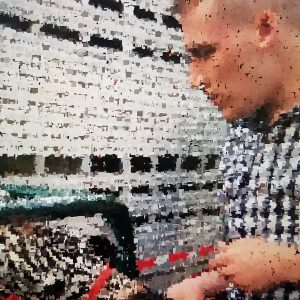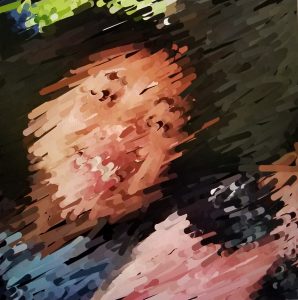//Owen D Haft
//15-104 Section D
//odh@andrew.cmu.edu
//Final Project
var wristJointX = 240; //X Position of the Wrist
var wristJointY = 240; //Y Position of the Wrist
var fingerJointRadius = 5; //Radius of the hand joints
var petalSize = 9; //Radius of the Petals
var petalHeight = 0; //Position of the Petals
//List of Translations
var Texts = ["Life is Beautiful", "La Vida es Bella",
"La Vie est Belle", "La Vita è Bella", "A Vida é Bela",
"Das Leben ist Wunderschoen", "Życie jest Piękne",
"החיים יפים", "لحياة جميلة", "삶은 아름답다", "生活是美好的",
"人生は素晴らしい", "ज़िन्दगी गुलज़ार है", "ชีวิตช่างสวยงาม",
"Maisha ni Mazuri", "Жизнь прекрасна", "Vita Pulchrum est"];
var THeight = 30; //Height of the Text
var TColor = 0; //Fill color of the Text
function setup() {
createCanvas(360, 360);
background(141, 222, 255);
}
function draw() {
stroke(0);
strokeWeight(1);
//Draws the Shapes of the Skeleton Hand
//Forearm
line(239, 241, 479, 481);
line(241, 239, 481, 479);
//Carpels
line(wristJointX, wristJointY, 210, 210);
line(wristJointX, wristJointY, 126, 234);
line(wristJointX, wristJointY, 124, 236);
line(wristJointX, wristJointY, 122, 238);
line(wristJointX, wristJointY, 120, 240);
//Metacarpels
line(210, 210, 185, 195);
line(126, 234, 110, 210);
line(124, 236, 95, 215);
line(122, 238, 85, 225);
line(122, 240, 80, 235);
line(110, 210, 135, 190);
line(95, 215, 80, 185);
line(85, 225, 65, 200);
line(80, 235, 55, 220);
//Styles the joints
fill(0);
strokeWeight(1);
stroke(250);
//Elbow
ellipse()
//Wrist Joint
ellipse(wristJointX, wristJointY, 10);
//Finger Joints
ellipse(126, 234, fingerJointRadius);
ellipse(124, 236, fingerJointRadius);
ellipse(122, 238, fingerJointRadius);
ellipse(120, 240, fingerJointRadius);
ellipse(80, 235, fingerJointRadius);
ellipse(85, 225, fingerJointRadius);
ellipse(95, 215, fingerJointRadius);
ellipse(110, 210, fingerJointRadius);
ellipse(210, 210, fingerJointRadius);
ellipse(55, 220, fingerJointRadius);
ellipse(65, 200, fingerJointRadius);
ellipse(80, 185, fingerJointRadius);
ellipse(135, 190, fingerJointRadius);
ellipse(185, 195, fingerJointRadius);
//Fingertips
strokeWeight(0); //Removes the outline on the fingertips
triangle(178, 193, 184, 190, 165, 185);
triangle(141, 188, 134, 183, 165, 185);
triangle(81, 179, 75, 181, 86, 155);
triangle(65, 194, 60, 197, 62, 172);
triangle(52, 214, 50, 220, 40, 202);
//Flower
//Stem
noFill();
strokeWeight(2); //Gives the Stem thickness
stroke(84, 157, 26); //Stem Color
curve(226, 154, 173, 156, 168, 195, 226, 191);
//Pod
fill(99, 47, 24);
ellipse(177, 153, 13);
//Petals
fill(255, 232, 19);
strokeWeight(0)
stroke(0);
//The Main text
push();
fill(TColor);
textSize(30);
text(Texts[0], 7, THeight); // Prints only "Life is Beautiful" from Texts
pop();
push();
translate(177, 153);
for (var i = 0; i < 6; i++) { //Creates the petals of the flower
rotate(PI/3);
ellipse(10, petalHeight, petalSize);
if (mouseIsPressed) { //Exapnds and moves the petals to
petalHeight -= 1; //encompass the Canvas in Yellow
petalSize += 1; //adding a new "background" color
if (petalSize > 500) { //Limits the growth of
petalHeight = 500; //the petals and prompts
petalSize = 500; //the Texts to be printed
//Prints Texts with offset heights
for (var j = 1; j < 18; j++) {
push();
translate(-180, -180);
fill(TColor + 255); //changes text color to white
textSize(16); //changes text size
text(Texts[j], random(10, 150), (THeight*2/3)*j+56);
pop();
};
};
};
};
pop();
//Draws pink petals once the yellow petals grow into the background
if (mouseIsPressed) {
translate(177, 153);
for (var i = 0; i < 6; i++) {
fill(219, 164, 164);
rotate(PI/3);
ellipse(10, 0, 9);
};
};
}I chose to create an interactive art piece for my final project. The work features a skeleton-like hand gently holding a small flower with the words above, “Life is Beautiful”. As the viewer holds down the mouse, the petals grow and replace the background color, as new petals appear in their place. Once the growing petals completely eclipse the background, the phrase “life is beautiful” appears randomly on the screen in different languages.
I was inspired by a sketch I made earlier in the year (below) and the beautiful juxtaposition of the subjects.

![[OLD FALL 2017] 15-104 • Introduction to Computing for Creative Practice](https://courses.ideate.cmu.edu/15-104/f2017/wp-content/uploads/2020/08/stop-banner.png)




